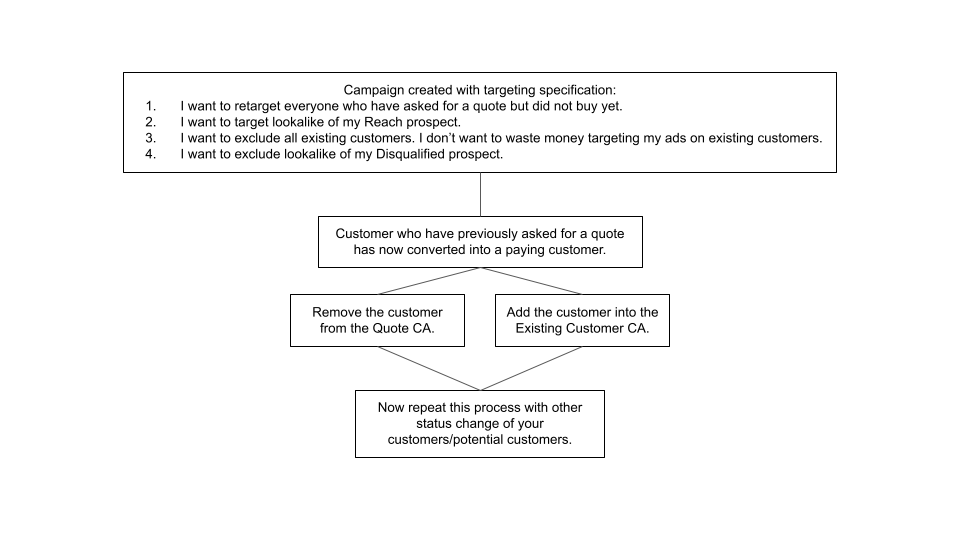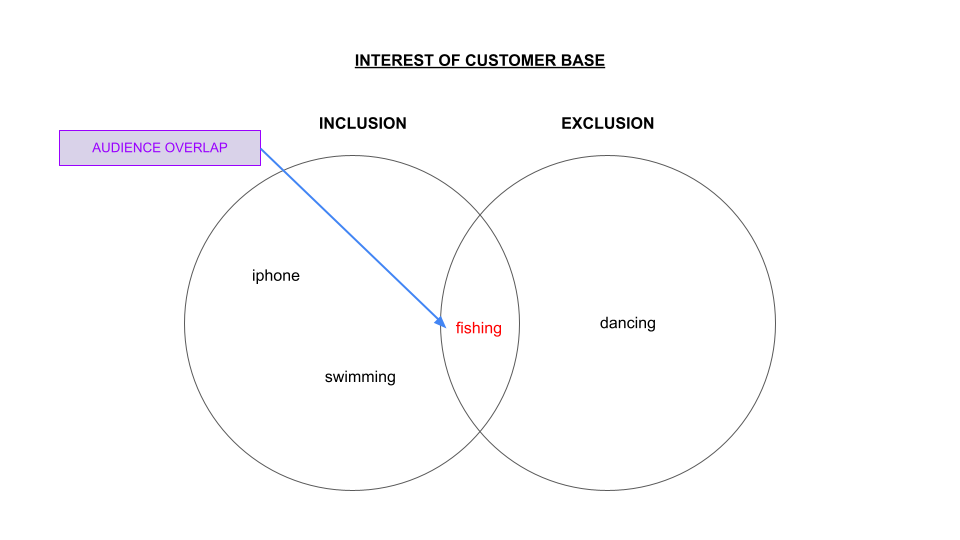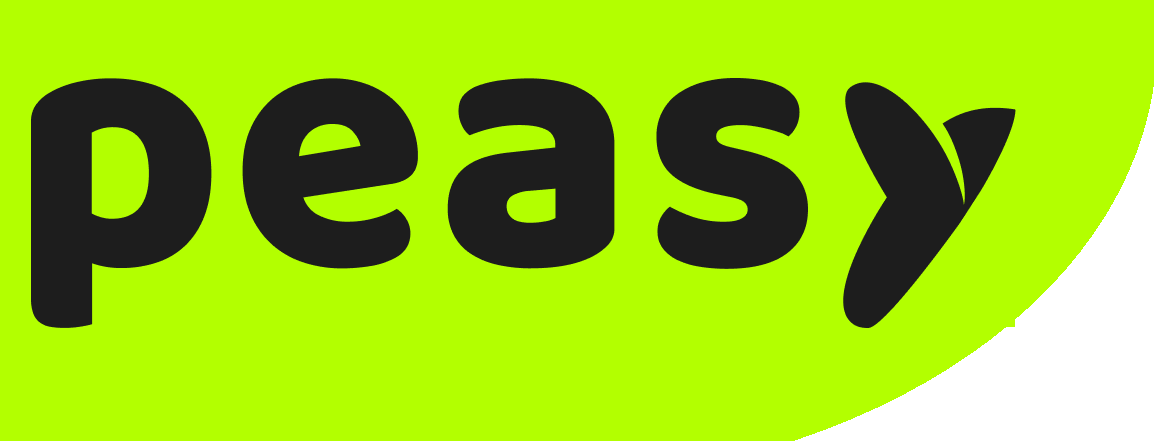In our previous article, we have established why Custom Audience (CA) and Lookalike Audience (LAL) is a lot more effective than interest-based targeting. But CA and LAL does have it’s own dark twist to it.
Think about it, have you ever experienced these situations when using CA and LAL:
- Cost per Acquisition in your campaign gradually increases.
- Campaign results and reach gradually decreases.
It could be your CA and LAL are facing any of these 3 problems:
- Custom Audiences are not created with right segmentation.
- Custom Audiences are not properly and regularly maintained.
- Overlap between Lookalike Audiences.
Custom Audiences are not created with right segmentation.
Not every customers are equal. What this means is that we should not treat every customer using only 1 method or approach. This is because every customer is on a different part or step of their purchasing/buying journey.
Imagine this is the customer journey of a B2B company: NEW –> REACH –> QUALIFIED –> NEGOTIATION –> WON
Status | Definition | Quantity |
New | Prospect who have register their interest on our website | 100,000 |
Reach | Prospect who have spoken to our sales people on the phone | 50,000 |
Qualified | Prospect which are deemed qualified, they have the budget, authority and need for our product | 30,000 |
Negotiation | Prospect who have asked for a quote | 15,000 |
Won | Customers whom we have issued invoice | 10,000 |
Lookalike will find other new audiences with similar characteristics of the seed audience which you have uploaded. If I were to ask you, which of the seed audience from the table above have a greater propensity to buy – you will definitely tell me “I want a lookalike of my Won customer, followed by Negotiation, Qualified, Reach and New”. That would make the most sense if your goal is to get more sales in the shortest amount of time because you would want to target a much more similar audience that has a higher intention and readiness to purchase.
So when you create a CA, you do not upload your entire list and create 1 single CA. You need to segment your customer list by conversion probability and create multiple CAs. For example, you would want to segment your CAs based on New, Reach, Qualified, Negotiation and Won. And in each of these, there will be an include and exclude list.
Why is this important?
As you can notice, the quantity at lower funnel phases (Won, Negotiation) are a lot less than those at the upper phases (New, Reach). So, suppose you are creating a campaign with a very low target quantity, it might be sufficient to just use the LAL of lower funnel phases (Won, Negotiation). For example, if your sales target are merely 10 sales, then using a 2% LAL of your Won customer with 600,000 population is more than sufficient. This way, your cost per acquisition will be lower compared to targeting LAL of Reach audience. But if your sales target is 1,000 sales, you might then want to use LAL of Won, Negotiation, Qualified and Reach.
Segmenting your LAL helps you keep the cost down. Click here to learn how to create multi-segmented CA and LAL
Custom Audiences are not properly and regularly maintained.
Now that your initial uploaded segments of Custom Audience and Lookalike Audience (LAL) is up and running, you have to constantly edit and update your contact list. This is because your customer would move on to the next phase of the buying journey or retract from it. When the changes occurs, you would have to update your CA and LAL in order to improve the accuracy of your targeting. This would also include adding in new contacts/customers.
Here is a sample scenario. Suppose you have created a campaign with this targeting specification:
- I want to retarget everyone who have asked for a quote but did not buy yet.
- I want to target lookalike of my Reach prospect.
- I want to exclude all existing customers. I don’t want to waste money targeting my ads on existing customers.
- I want to exclude lookalike of my Disqualified prospect.

Now, imagine if a customer who have previously asked for a quote has now converted into a paying customer, you’ll need to:
- Remove the customer from the Quote CA.
- Add the customer into the Existing Customer CA.
Otherwise, your campaign will waste money targeting an existing customer.
Or, imagine if a reachable prospect have now been deemed disqualified:
- You will have to remove the contact from Reach CA.
- And, add the contact into the Disqualified CA.
Otherwise, your campaign will waste money targeting bad-quality leads.
In order to maintain the efficacy of your CA and LAL, you will need to regularly maintain and update your CA and LAL whenever a contact status changes. Click here on learn how you can maintain your CA and LAL.
Overlap between Lookalike Audiences (LAL).
In our previous article, we have established LAL allows us to find new audiences with similar characteristics as the seed audience (contact/customer list) which you have uploaded onto Facebook. So that after a period of time, the algorithm and AI will be able to learn who your ads should reach out to and who it should not.
We have also established in the previous article that campaign targeting has inclusion (people I want to target) and exclusion (people I want to avoid). With these, you would be able to take advantage of those differences within your contact list and generate more advanced lookalike models.
A takeaway from previous article also tells you that you should use LAL of good status (Won, Negotiation, Qualified, Reach, New) in your campaign’s inclusion and LAL of bad status (Disqualified) in your campaign’s exclusion. This is to enable the system to learn which group of people they needs to see your ads and which group of people it should not waste your resources on.
But what if the common characteristics of your good audiences are (for example: “fishing”, “swimming”, “iphone”) and your bad audiences are (for example: “fishing”, “dancing”). 1 characteristics should not co-exist on both status simultaneously but since fishing exist on both LAL, how will your campaign target and avoid the same people at the same time?

When this happen, we term it as audience overlap. When audience overlap happen, your campaign will:
- Behave erratically, cost and results constantly fluctuate.
- Campaign results may be inaccurate to rely on..
- LAL will not run properly.
Click here to learn how to check and prevent overlap.
Explore our live B2B demo
Get a FREE consultation
Testimonies
Hear what some of our B2B users have to say about Peasy
Mr. Shahrul, owner of Trivantage Partners Sdn Bhd (a food packaging company) is excited about how Peasy has simplified and automated marketing and sales for his company. He believes that small businesses, which are always short on time, can benefit from Peasy's automation.
